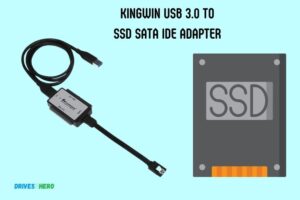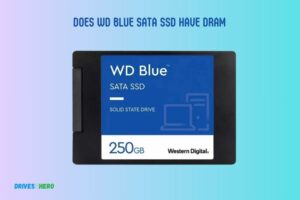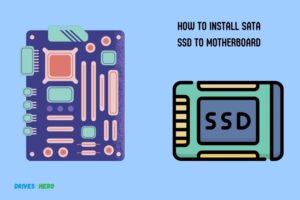Is Nvme Ssd Faster Than Sata Ssd? Yes!
Yes, NVMe SSD is faster than SATA SSD. NVMe (Non-Volatile Memory Express) SSDs are known for their superior speed and performance compared to SATA (Serial ATA) SSDs.
NVMe SSDs are designed to leverage the capabilities of high-speed PCIe (Peripheral Component Interconnect Express) lanes and Non-Volatile Memory (NVM) technology, providing fast data transfer rates and high-performance levels.
On the other hand, SATA SSDs are slower because they utilize the SATA bus, which was initially designed for hard disk drives (HDDs) and is considerably slower than PCIe lanes used by NVMe SSDs.
If speed and performance are what you’re after, NVMe SSDs are your best bet. They have far higher read/write speeds thanks to the advanced PCIe lanes and NVM technology they employ.
Although SATA SSDs are a significant improvement over traditional HDDs, they still lag behind NVMe SSDs in terms of speed.
6 Features Of NVMe SSD vs SATA SSD
| Feature | NVMe SSD | SATA SSD |
|---|---|---|
| Maximum Speed | 3500 MB/s | 600 MB/s |
| Average Speed | 2000 MB/s | 550 MB/s |
| Connection Interface | PCIe | SATA |
| Latency | Low | High |
| Price | More expensive | Less expensive |
| Power Consumption | High | Low |
Key Takeaway

Five Facts About the Speed Difference Between NVMe SSD and SATA SSD
Understanding The Basics Of Nvme And Sata Ssds
NVMe SSDs offer faster performance compared to SATA SSDs. With their advanced technology and higher data transfer rates, NVMe SSDs are capable of delivering significant speed improvements for various applications and tasks.
NVMe (Non-Volatile Memory Express) and SATA (Serial Advanced Technology Attachment) are two different types of solid-state drives (SSDs) commonly used in computers and other electronic devices.
While both offer storage capabilities, there are significant differences between the two in terms of performance and connectivity.
We will provide a brief explanation of NVMe SSDs and SATA SSDs to help you understand their key features and benefits.
Brief Explanation Of Nvme Ssds:
- NVMe SSDs are based on a newer storage protocol designed specifically for flash-based storage devices.
- They use the PCIe (Peripheral Component Interconnect Express) interface, which allows for faster data transfer rates and lower latency compared to SATA SSDs.
- NVMe SSDs can achieve significantly higher read and write speeds, making them ideal for demanding applications that require quick access to large amounts of data.
- These SSDs are available in various form factors, including M.2 and add-in card (AIC), allowing for easy installation in different devices such as laptops, desktops, and servers.
Brief Explanation Of Sata Ssds:
- SATA SSDs are based on the SATA interface, which has been widely used for traditional hard drives.
- They offer lower data transfer rates and higher latency compared to NVMe SSDs, but still provide significant improvements over mechanical hard drives.
- SATA SSDs are often more affordable than NVMe SSDs, making them a popular choice for budget-conscious consumers or those who do not require ultra-fast storage capabilities.
- They are available in standard 2.5-inch form factor or as M.2 SATA drives, providing flexibility for different types of devices.
NVMe SSDs and SATA SSDs differ in terms of performance and connectivity. NVMe SSDs utilize the PCIe interface and offer faster read and write speeds, while SATA SSDs use the SATA interface and are generally more affordable.
Understanding these basic differences can help you make an informed decision when choosing the right SSD for your needs.
The Speed Factor: Comparing Nvme And Sata Ssd Performance
Discover the truth about NVMe and SATA SSD performance in this in-depth comparison. Explore the speed factor and find out if NVMe SSDs are truly faster than SATA SSDs.
When it comes to storage solutions for your computer, SSDs (Solid-State Drives) have become the preferred choice over traditional HDDs (Hard Disk Drives).
But within the realm of SSDs, there are different types to consider. NVMe (Non-Volatile Memory Express) SSDs and SATA (Serial ATA) SSDs are two popular options.
Both offer significant performance improvements compared to HDDs, but what sets them apart? We will delve into the speed factor and compare the performance of NVMe and SATA SSDs.
Key Differences In Data Transfer Protocols:
SATA SSDs:
- Use the SATA III interface.
- Have a theoretical maximum data transfer rate of 6 Gigabits per second (Gbps).
- Utilize AHCI (Advanced Host Controller Interface) protocol, originally designed for HDDs.
NVMe SSDs:
- Employ the PCIe (Peripheral Component Interconnect Express) interface.
- Offer significantly higher data transfer rates compared to SATA SSDs.
- Embrace the NVMe protocol optimized for SSDs, delivering enhanced performance.
Analyzing Sequential Read And Write Speeds:
SATA SSDs:
- Generally offer sequential read and write speeds ranging from 500 to 550 Megabytes per second (MB/s).
- Deliver reliable performance for everyday computing tasks and gaming.
NVMe SSDs:
- Can achieve sequential read speeds of over 3,000 MB/s and write speeds of up to 2,500 MB/s.
- Provide blazing-fast performance, ideal for demanding applications like video editing and 3D rendering.
Evaluating Random Read And Write Speeds:
SATA SSDs:
- Typically exhibit random read and write speeds in the range of 80,000 to 100,000 IOPS (Input/Output Operations Per Second).
- Offer snappy system responsiveness and faster file access.
NVMe SSDs:
- Showcase random read speeds of more than 500,000 IOPS and write speeds surpassing 400,000 IOPS.
- Deliver lightning-fast access to small files and significant improvements in multitasking scenarios.
NVMe SSDs outshine SATA SSDs in terms of speed and performance. The NVMe protocol’s direct communication with the PCIe interface eliminates the bottlenecks present in the SATA III interface and AHCI protocol.
This advantage leads to significantly higher sequential and random read and write speeds with NVMe SSDs. If you’re seeking the fastest storage solution available, NVMe SSDs are the way to go.
They provide unrivaled speed and performance, making them an excellent choice for enthusiasts, professionals, and anyone looking to supercharge their computing experience.
Factors Affecting Nvme And Sata Ssd Performance
NVMe SSDs have faster performance compared to SATA SSDs due to several factors, such as higher bandwidth, lower latency, and improved queuing technology.
These factors contribute to quicker data transfer, improved loading times, and enhanced overall system responsiveness.
Solid-state drives (SSDs) have revolutionized the storage industry with their superior performance over traditional hard disk drives (HDDs).
When it comes to SSDs, NVMe (Non-Volatile Memory Express) and SATA (Serial Advanced Technology Attachment) are two popular interfaces.
However, you might be wondering if NVMe SSDs are faster than SATA SSDs. To understand this, we need to consider the factors that affect the performance of both NVMe and SATA SSDs.
Impact Of Storage Controllers On Speed:
The storage controller is a crucial component of an SSD that manages data transfers and communication between the drive and the computer’s motherboard.
When it comes to speed, the controller plays a significant role. Here’s how it impacts NVMe and SATA SSD performance:
- NVMe SSDs utilize a streamlined and more efficient storage controller designed specifically for flash-based memory, resulting in faster data transfer rates.
- SATA SSDs, on the other hand, rely on a storage controller that was primarily developed for HDDs. While it still offers good performance, it cannot match the speed of NVMe SSDs.
Impact Of Cache Size On Performance:
SSDs often include a cache, which is a small amount of high-speed memory that acts as a temporary storage space for frequently accessed data.
The cache size can influence the performance of both NVMe and SATA SSDs:
- A larger cache size allows for more data to be stored, resulting in faster read and write speeds.
- NVMe SSDs generally feature larger caches than SATA SSDs, further improving their performance.
Influence Of Storage Capacity On Speed:
The storage capacity of an SSD can also impact its performance.
Here’s how it affects NVMe and SATA SSDs:
- NVMe and SATA SSDs tend to have similar performance characteristics regardless of their capacity.
- However, in some cases, larger capacity SSDs can offer slightly faster speeds due to more advanced memory controllers and additional NAND flash memory chips.
To summarize, both NVMe and SATA SSDs have their own strengths and performance advantages. NVMe SSDs excel in speed, thanks to their optimized storage controllers, larger caches, and potential for higher capacities.
On the other hand, SATA SSDs still offer respectable performance and remain a cost-effective choice for many users.
Consider your specific needs and budgetary constraints when deciding between these two SSD types.
Real-World Performance Comparison: Nvme Vs Sata Ssds
NVMe SSDs offer significantly faster performance compared to SATA SSDs, delivering faster data transfer speeds and reduced latency.
With NVMe technology, users can experience improved overall system performance due to its faster read and write speeds.
When it comes to choosing the right SSD for your storage needs, understanding the real-world performance of different options is crucial.
We will explore the performance of NVMe (Non-Volatile Memory Express) and SATA (Serial ATA) SSDs in various scenarios.
Let’s dive in and see how these two popular storage technologies compare.
Performance In Everyday Tasks:
- Boot time: NVMe SSDs offer significantly faster boot times due to their high read and write speeds, ensuring you can start your system in a flash.
- File transfers: NVMe SSDs excel in transferring large files, such as videos or high-resolution images, as they leverage their superior sequential read and write speeds.
- Application loading: With NVMe SSDs, applications launch faster, allowing you to work more efficiently.
- Multitasking: NVMe SSDs handle multitasking capabilities better than SATA SSDs, allowing you to switch between applications without experiencing any noticeable slowdown.
Performance In Gaming And Multimedia Applications:
- Game loading: NVMe SSDs provide faster load times for games, reducing waiting time and allowing you to jump into the action quickly.
- Seamless gameplay: NVMe SSDs offer improved performance in open-world games that require frequent data streaming, minimizing stuttering and providing a smoother gaming experience.
- Video editing: NVMe SSDs shine when it comes to video editing tasks, enabling faster rendering and scrubbing through high-resolution footage smoothly.
- Media creation: Whether you are working with large audio files or manipulating graphics, NVMe SSDs deliver quicker access to data, enhancing both productivity and creative workflow.
Performance In Professional Workloads:
- Data analysis: For professionals dealing with big data and complex calculations, NVMe SSDs significantly reduce processing times, leading to improved productivity.
- Virtualization: NVMe SSDs handle virtual machine disk files more efficiently, allowing for smoother virtualization performance and reducing lag.
- Content creation: Whether you’re a photographer, graphic designer, or architect, NVMe SSDs enhance work processes that involve large file sizes and resource-intensive software.
- Database management: With faster read and write speeds, NVMe SSDs accelerate database operations, benefiting professionals in various fields, including IT and finance.
NVMe SSDs outperform SATA counterparts in real-world scenarios, providing faster boot times, quicker application loading, smoother gameplay, improved multimedia editing, and enhanced performance in professional workloads.
Whether you’re a gamer, content creator, or professional, choosing an NVMe SSD can significantly enhance your overall computing experience.
Considerations For Choosing Between Nvme And Sata Ssds
NVMe SSDs offer faster performance compared to SATA SSDs due to their superior interface, making them an ideal choice for tasks that demand high-speed data transfer, such as gaming or video editing.
However, when choosing between the two, it’s essential to consider factors like budget, storage capacity, and compatibility with existing hardware.
NVMe and SATA SSDs are both popular options for increasing storage and speeding up computer systems.
However, it’s important to consider various factors when choosing between the two. Below are some key considerations to keep in mind:
Cost-effectiveness of NVMe vs SATA SSDs:
- NVMe SSDs tend to be more expensive than SATA SSDs, primarily due to their faster speeds and advanced technology.
- SATA SSDs are generally more affordable and provide a cost-effective solution for those with budget constraints.
Compatibility with different computer systems:
- SATA SSDs have been around longer and are compatible with a wide range of computer systems, including older ones.
- NVMe SSDs, on the other hand, require a motherboard with an M.2 slot that supports the NVMe protocol. Ensure that your computer system can accommodate NVMe SSDs before making a purchase.
Future-proofing and scalability considerations:
- NVMe SSDs offer faster speeds, making them ideal for demanding tasks such as gaming or video editing. If you require blazing-fast data transfer, NVMe is the way to go.
- SATA SSDs, while not as lightning-fast as NVMe, still provide a significant improvement over traditional hard drives. They are a reliable choice for everyday use and general computing tasks.
When it comes to choosing between NVMe and SATA SSDs, it ultimately depends on your specific needs and budget. Consider the factors outlined above to make an informed decision that suits your requirements.
Remember, it’s always a good idea to compare prices, read customer reviews, and consult experts before investing in any storage solution. By doing so, you can ensure you’re making the right choice for your computer system.
FAQ On Is Nvme Ssd Faster Than Sata Ssd
How Much Better Is Nvme Than Ssd?
NVMe is significantly faster than SSD, offering improved performance and faster data transfer speeds.
What Is The Speed Of Nvme Over Sata?
The speed of NVMe over SATA is significantly faster due to its direct connection to the PCIe bus.
Is Nvme Faster Than Sata Ssd In Gaming?
NVMe SSDs are faster than SATA SSDs in gaming due to their higher data transfer rates.
How Much Faster Is Nvme Ssd Than Hdd?
NVMe SSDs are significantly faster than HDDs, offering a substantial boost in performance.
Is Nvme Ssd Faster Than Sata Ssd?
Yes, NVMe SSDs are significantly faster than SATA SSDs due to their direct connection to the motherboard.
Conclusion
The comparison between NVMe SSD and SATA SSD clearly highlights the significant performance advantages of NVMe technology.
Through its use of PCIe lanes and high-speed flash storage, NVMe SSDs offer faster data transfer rates, shorter response times, and improved overall system performance.
This makes them an ideal choice for users who require lightning-fast speeds, such as gamers or professionals working with large files and data-intensive applications.
NVMe ssd also provide enhanced multitasking capabilities and reduced power consumption in comparison to SATA SSDs.
While SATA SSDs are still a reliable and cost-effective option for many users, the increasing availability and affordability of NVMe SSDs make them a worthy investment for those seeking the highest level of performance.
Considering the clear advantages NVMe SSDs bring to the table, it is evident that they have become the preferred choice for SSD technology.
Thus, for anyone seeking exceptional speed and performance, NVMe SSDs undoubtedly offer the answer.






